Spatiotemporal Variations and Sustainability Characteristics of Groundwater Storage in North China from 2002 to 2022 Revealed by GRACE/GRACE Follow-On and Multiple Hydrologic Data
Abstract
:1. Introduction
2. Data and Methods
2.1. Study Area
2.2. GRACE/GRACE-FO Data and Calculation of TWS Changes
2.3. Hydrological Data and Estimation of GWS Changes from GRACE/GRACE-FO
2.4. The South-to-North Water Transfer Project and Groundwater Extraction Data
2.5. Groundwater Sustainability Index
2.6. In Situ Groundwater-Level Data
3. Results
3.1. Time Series Characteristics of TWS and GWS in NC
3.2. GWS Time Series Variation in NC
- (1)
- In 2004, the annual mean precipitation anomaly in NC reached 55.83 mm (Figure 4c) and correlated with an increase in GWS (Figure 4a). The annual average precipitation anomaly and annual ΔGWS were negative from 2004 to 2009 (Figure 4c), coinciding with a decrease in GWS (line segment A in Figure 4a). The depletion rate obtained by fitting the GWS with a straight line was approximately −1.61 ± 0.37 cm/a from 2004 to 2009.
- (2)
- From 2010 to 2013, the precipitation anomaly increased, changing from negative to positive (Figure 4c); in 2012, the annual ΔGWS was positive and correlating with a reduced decrease rate in GWS (line B in Figure 4a), namely, −0.71 ± 0.76 cm/a, suggesting that rainfall can partially compensate for the loss of GWS due to groundwater overexploitation, especially in 2012.
- (3)
- During 2014–2017, GWS decreased sharply at a rate of −3.91 ± 0.69 cm/a, despite the precipitation anomaly reaching its maximum in 2016. The annual ΔGWS is negative (Figure 4c). This decrease in GWS may be attributed to overexploitation, which led to an imbalance between rainfall recharge and groundwater depletion; therefore, groundwater could not be sufficiently replenished [20,23]. During this period, NC was in drought, with decreased rainfall and increased evaporation [68]. Owing to the overexploitation of groundwater, the water layer in the zone of aeration thickened, which prolonged the GWS recharge cycle and reduced recharge [23]. During 2014–2017, the rate of GWS decline accelerated (line segment C in Figure 4a). However, GWS in Beijing and Tianjin recovered slightly because of the SNWTP in 2014.
- (4)
- During 2018–2022, the GWS decreased at a rate of −1.16 ± 0.81 cm/a. The change in GWS derived from GRACE-FO data (line segment D in Figure 4a) is similar to the changes estimated using GRACE data in 2014–2017. Although a small overall decrease was present in GWS from 2018 to 2022, the annual ΔGWS during this period showed an initial deficit followed by a surplus. This trend was due to a sharp increase in rainfall in 2020 and 2021, indicating that rainfall can effectively replenish GWS (Figure 4b,c). In addition, the SNWTP may replenish groundwater in NC [28,30].
3.3. Spatial Interannual Variation in GWS in NC
4. Discussion
4.1. Comparison with In Situ Groundwater-Level Data from Monitoring Well
4.2. Spatial and Temporal Variability of Groundwater Sustainability in NC
4.3. SNWTP’s Impact on GWS and Estimation of the Overall Hydrological Cycle in NC
4.4. Comparison with Previous Results
5. Conclusions
- (1)
- The results of GRACE and GRACE-FO showed that NC is an important region in China with continuous reductions in both TWS and GWS. The GTCH method can effectively integrate the six GRACE/GRACE-FO products. The time series TWS data showed a large variation in amplitude across the period 2002–2022, and the rate of decrease in TWS was approximately −1.40 ± 0.14 cm/a. GWS decreased from 2002 to 2022, with an average decrease rate of approximately −1.81 ± 0.09 cm/a.
- (2)
- We found significant differences in the variation in GWS for different periods in NC. GWS decreased from −1.61 ± 0.37 cm/a in 2004–2009, −0.71 ± 0.76 cm/a in 2010–2013, −3.91 ± 0.69 cm/a in 2014–2017, and −1.16 ± 0.81 cm/a in 2018–2022. A slight increase in GWS was present in 2021 and 2022, as a result mainly of a remarkable increase in precipitation. Groundwater sustainability in NC ranged from mildly unsustainable in 2004–2009 and severely unsustainable in 2010–2013 and 2014–2017 to mildly unsustainable in 2018–2022.
- (3)
- We showed good agreement between the GWS inverted by the GRACE/GRACE-FO data (−1.99 ± 0.10 cm/a) and the GWS changes revealed using the in situ groundwater level (−2.03 ± 0.12 cm/a) for 2005–2021. A larger change was present in the deep groundwater level (−0.61 ± 0.04 m/a) compared with that in the shallow groundwater level (−0.21 ± 0.02 m/a), indicating that deep groundwater extraction is serious in NC.
- (4)
- Following SNWTP implementation, the correlation between rainfall and GWS became weaker, probably because drought or the SNWTP changed the water supply structure. More important, we found that the mean annual groundwater recharges was 137.30 km3, while the annual pumping was 201.31 km3 from 2002 to 2019. Groundwater replenishment is less than pumping, which explains the decline in GWS. By 2021, the SNWTP replenished a cumulative approximately 27.75 km3 of groundwater.
Author Contributions
Funding
Data Availability Statement
Acknowledgments
Conflicts of Interest
References
- Zhong, M.; Duan, J.; Xu, H.; Peng, P.; Yan, H.; Zhu, Y. Trend of China land water storage redistribution at medi-and large-spatial scales in recent five years by satellite gravity observations. Chin. Sci. Bull. 2009, 54, 816–821. [Google Scholar] [CrossRef]
- Feng, W.; Shum, C.; Zhong, M.; Pan, Y. Groundwater storage changes in China from satellite gravity: An overview. Remote Sens. 2018, 10, 674. [Google Scholar] [CrossRef]
- Qu, W.; Jin, Z.; Zhang, Q.; Gao, Y.; Zhang, P.; Chen, P. Estimation of Evapotranspiration in the Yellow River Basin from 2002 to 2020 Based on GRACE and GRACE Follow-On Observations. Remote Sens. 2022, 14, 730. [Google Scholar] [CrossRef]
- Wang, D.; Zhao, B.; Li, Y.; Yu, J.; Chen, Y.; Zhou, X. Determination of tectonic and nontectonic vertical motion rates of the North China Craton using dense GPS and GRACE data. J. Asian Earth Sci. 2022, 236, 105314. [Google Scholar] [CrossRef]
- Shen, Y.; Zheng, W.; Zhu, H.; Yin, W.; Xu, A.; Pan, F.; Wang, Q.; Zhao, Y. Inverted Algorithm of Groundwater Storage Anomalies by Combining the GNSS, GRACE/GRACE-FO, and GLDAS: A Case Study in the North China Plain. Remote Sens. 2022, 14, 5683. [Google Scholar] [CrossRef]
- Pang, Y.; Zhang, H.; Cheng, H.; Shi, Y.; Fang, C.; Luan, X.; Chen, S.; Li, Y.; Hao, M. The modulation of groundwater exploitation on crustal stress in the North China Plain, and its implications on seismicity. J. Asian Earth Sci. 2020, 189, 104141. [Google Scholar] [CrossRef]
- Yu, W.; Gong, H.; Chen, B.; Zhou, C.; Zhang, Q. Combined GRACE and MT-InSAR to assess the relationship between groundwater storage change and land subsidence in the Beijing-Tianjin-Hebei Region. Remote Sens. 2021, 13, 3773. [Google Scholar] [CrossRef]
- Schmidt, R.; Petrovic, S.; Güntner, A.; Barthelmes, F.; Wünsch, J.; Kusche, J. Periodic components of water storage changes from GRACE and global hydrology models. J. Geophys. Res. Solid Earth 2008, 113, 1–14. [Google Scholar] [CrossRef]
- Wang, H.; Jia, L.; Steffen, H.; Wu, P.; Jiang, L.; Hsu, H.; Xiang, L.; Wang, Z.; Hu, B. Increased water storage in North America and Scandinavia from GRACE gravity data. Nat. Geosci. 2013, 6, 38–42. [Google Scholar] [CrossRef]
- Rodell, M.; Reager, J.T. Water cycle science enabled by the GRACE and GRACE-FO satellite missions. Nat. Water 2023, 1, 47–59. [Google Scholar] [CrossRef]
- Su, X.; Ping, J.; Ye, Q. Terrestrial water variations in the North China Plain revealed by the GRACE mission. Sci. China Earth Sci. 2011, 54, 1965–1970. [Google Scholar] [CrossRef]
- Moiwo, J.P.; Tao, F.; Lu, W. Analysis of satellite-based and in situ hydro-climatic data depicts water storage depletion in North China Region. Hydrol. Process. 2013, 27, 1011–1020. [Google Scholar] [CrossRef]
- Feng, W.; Zhong, M.; Lemoine, J.M.; Biancale, R.; Hsu, H.T.; Xia, J. Evaluation of groundwater depletion in North China using the Gravity Recovery and Climate Experiment (GRACE) data and ground-based measurements. Water Resour. Res. 2013, 49, 2110–2118. [Google Scholar] [CrossRef]
- Wang, F.; Wang, Z.; Yang, H.; Di, D.; Zhao, Y.; Liang, Q. Utilizing GRACE-based groundwater drought index for drought characterization and teleconnection factors analysis in the North China Plain. J. Hydrol. 2020, 585, 124849. [Google Scholar] [CrossRef]
- Huang, Z.; Pan, Y.; Gong, H.; Yeh, P.J.F.; Li, X.; Zhou, D.; Zhao, W. Subregional-scale groundwater depletion detected by GRACE for both shallow and deep aquifers in North China Plain. Geophys. Res. Lett. 2015, 42, 1791–1799. [Google Scholar] [CrossRef]
- Tang, Q.; Zhang, X.; Tang, Y. Anthropogenic impacts on mass change in North China. Geophys. Res. Lett. 2013, 40, 3924–3928. [Google Scholar] [CrossRef]
- Li, L.; Chen, L.; Wang, L. A research on terrestrial water storage variations with grace satellite data in the Jing-Jin-Ji region. In Proceedings of the 2016 IEEE International Geoscience and Remote Sensing Symposium (IGARSS), Beijing, China, 10–15 July 2016; pp. 6225–6228. [Google Scholar]
- Feng, W.; Wang, C.-Q.; Mu, D.-P.; Zhong, M.; Zhong, Y.-L.; Xu, H.-Z. Groundwater storage variations in the North China Plain from GRACE with spatial constraints. Chin. J. Geophys. 2017, 60, 1630–1642. [Google Scholar] [CrossRef]
- Yin, W.; Han, S.-C.; Zheng, W.; Yeo, I.-Y.; Hu, L.; Tangdamrongsub, N.; Ghobadi-Far, K. Improved water storage estimates within the North China Plain by assimilating GRACE data into the CABLE model. J. Hydrol. 2020, 590, 125348. [Google Scholar] [CrossRef]
- Zhao, Q.; Zhang, B.; Yao, Y.; Wu, W.; Meng, G.; Chen, Q. Geodetic and hydrological measurements reveal the recent acceleration of groundwater depletion in North China Plain. J. Hydrol. 2019, 575, 1065–1072. [Google Scholar] [CrossRef]
- Ebead, B.M.; Ahmed, M.E.; Niu, Z.; Huang, N. Quantifying the anthropogenic impact on groundwater resources of North China using Gravity Recovery and Climate Experiment data and land surface models. J. Appl. Remote Sens. 2017, 11, 026029. [Google Scholar] [CrossRef]
- Zhu, B.; Xie, X.; Zhang, K. Water storage and vegetation changes in response to the 2009/10 drought over North China. Hydrol. Res. 2018, 49, 1618–1635. [Google Scholar] [CrossRef]
- Li, Z.; Zhang, C.; Ke, B.; Liu, Y.; Li, W.; Yin, C. North China Plain water storage variation analysis based on GRACE and seasonal influence considering. Acta Geod. Geophys. Sin. 2018, 47, 940. [Google Scholar]
- Huang, Q.; Zhang, Q.; Xu, C.-Y.; Li, Q.; Sun, P. Terrestrial Water Storage in China: Spatiotemporal Pattern and Driving Factors. Sustainability 2019, 11, 6646. [Google Scholar] [CrossRef]
- Huang, T.; Pang, Z. Groundwater Recharge and Dynamics in Northern China: Implications for Sustainable Utilization of Groundwater. Procedia Earth Planet. Sci. 2013, 7, 369–372. [Google Scholar] [CrossRef]
- Wu, M.; Wu, J.; Liu, J.; Wu, J.; Zheng, C. Effect of groundwater quality on sustainability of groundwater resource: A case study in the North China Plain. J. Contam. Hydrol. 2015, 179, 132–147. [Google Scholar] [CrossRef] [PubMed]
- Xu, Y.; Gong, H.; Chen, B.; Zhang, Q.; Li, Z. Long-term and seasonal variation in groundwater storage in the North China Plain based on GRACE. Int. J. Appl. Earth Obs. Geoinf. 2021, 104, 102560. [Google Scholar] [CrossRef]
- Zhang, C.; Duan, Q.; Yeh, P.J.-F.; Pan, Y.; Gong, H.; Moradkhani, H.; Gong, W.; Lei, X.; Liao, W.; Xu, L. Sub-regional groundwater storage recovery in North China Plain after the South-to-North water diversion project. J. Hydrol. 2021, 597, 126156. [Google Scholar] [CrossRef]
- Liu, R.; Zhong, B.; Li, X.; Zheng, K.; Liang, H.; Cao, J.; Yan, X.; Lyu, H. Analysis of groundwater changes (2003–2020) in the North China Plain using geodetic measurements. J. Hydrol. Reg. Stud. 2022, 41, 101085. [Google Scholar] [CrossRef]
- Xiong, J.; Yin, J.; Guo, S.; Yin, W.; Rao, W.; Chao, N. Using GRACE to detect groundwater variation in North China Plain after south-north water diversion. Groundwater 2022, 610, 127799. [Google Scholar] [CrossRef]
- He, J.; Ju, J.; Wen, Z.; Lü, J.; Jin, Q. A review of recent advances in research on Asian monsoon in China. Adv. Atmos. Sci. 2007, 24, 972–992. [Google Scholar] [CrossRef]
- Wang, B.; Wu, Z.; Chang, C.-P.; Liu, J.; Li, J.; Zhou, T. Another look at interannual-to-interdecadal variations of the East Asian winter monsoon: The northern and southern temperature modes. J. Clim. 2010, 23, 1495–1512. [Google Scholar] [CrossRef]
- Yang, H.; Cao, W.; Zhi, C.; Li, Z.; Bao, X.; Ren, Y.; Liu, F.; Fan, C.; Wang, S.; Yabin, W. Evolution of groundwater level in the North China Plain in the past 40 years and suggestions on its overexploitation treatment. Geol. China 2021, 48, 1142–1155. [Google Scholar] [CrossRef]
- Wang, R.; Lin, J.; Zhao, B.; Li, L.; Xiao, Z.; Pilz, J. Integrated Approach for Lithological Classification Using ASTER Imagery in a Shallowly Covered Region—The Eastern Yanshan Mountain of China. IEEE J. Sel. Top. Appl. Earth Obs. Remote Sens. 2018, 11, 4791–4807. [Google Scholar] [CrossRef]
- Liu, M.; Pei, H.; Shen, Y. Evaluating dynamics of GRACE groundwater and its drought potential in Taihang Mountain Region, China. J. Hydrol. 2022, 612, 128156. [Google Scholar] [CrossRef]
- He, K.; Zhang, S.; Wang, F.; Du, W. The karst collapses induced by environmental changes of the groundwater and their distribution rules in North China. Environ. Earth Sci. 2010, 61, 1075–1084. [Google Scholar] [CrossRef]
- Liu, C.; Yu, J.; Kendy, E. Groundwater exploitation and its impact on the environment in the North China Plain. Water Int. 2001, 26, 265–272. [Google Scholar] [CrossRef]
- Niu, X. The First Stage of the Middle-Line South-to-North Water-Transfer Project. Engineering 2022, 16, 21–28. [Google Scholar] [CrossRef]
- Cheng, M.; Ries, J. The unexpected signal in GRACE estimates of C20. J. Geod. 2017, 91, 897–914. [Google Scholar] [CrossRef]
- Loomis, B.D.; Rachlin, K.E.; Wiese, D.N.; Landerer, F.W.; Luthcke, S.B. Replacing GRACE/GRACE-FO with satellite laser ranging: Impacts on Antarctic Ice Sheet mass change. Geophys. Res. Lett. 2020, 47, e2019GL085488. [Google Scholar] [CrossRef]
- Sun, Y.; Riva, R.; Ditmar, P. Optimizing estimates of annual variations and trends in geocenter motion and J2 from a combination of GRACE data and geophysical models. J. Geophys. Res. Solid Earth 2016, 121, 8352–8370. [Google Scholar] [CrossRef]
- Peltier, W.R.; Argus, D.F.; Drummond, R. Space geodesy constrains ice age terminal deglaciation: The global ICE-6G_C (VM5a) model. J. Geophys. Res. Solid Earth 2015, 120, 450–487. [Google Scholar] [CrossRef]
- Landerer, F.W.; Swenson, S.C. Accuracy of scaled GRACE terrestrial water storage estimates. Water Resour. Res. 2012, 48, 1–11. [Google Scholar] [CrossRef]
- Rodell, M.; Velicogna, I.; Famiglietti, J.S. Satellite-based estimates of groundwater depletion in India. Nature 2009, 460, 999–1002. [Google Scholar] [CrossRef]
- Save, H.; Bettadpur, S.; Tapley, B.D. High-resolution CSR GRACE RL05 mascons. J. Geophys. Res. Solid Earth 2016, 121, 7547–7569. [Google Scholar] [CrossRef]
- Wahr, J.; Swenson, S.; Velicogna, I. Accuracy of GRACE mass estimates. Geophys. Res. Lett. 2006, 33, L06401. [Google Scholar] [CrossRef]
- Landerer, F.W.; Flechtner, F.M.; Save, H.; Webb, F.H.; Bandikova, T.; Bertiger, W.I.; Bettadpur, S.V.; Byun, S.H.; Dahle, C.; Dobslaw, H. Extending the global mass change data record: GRACE Follow-On instrument and science data performance. Geophys. Res. Lett. 2020, 47, e2020GL088306. [Google Scholar] [CrossRef]
- Loomis, B.D.; Luthcke, S.B.; Sabaka, T.J. Regularization and error characterization of GRACE mascons. J. Geod. 2019, 93, 1381–1398. [Google Scholar] [CrossRef]
- Galindo, F.J.; Ruiz, J.J.; Giachino, E.; Premoli, A.; Tavella, P. Estimation of the covariance matrix of individual standards by means of comparison measurements. In Advanced Mathematical and Computational Tools in Metrology V; Ciarlini, P., Cox, M.G., Filipe, E., Pavese, F., Richter, D., Eds.; World Scientific: Caparica, Portugal, 2001; pp. 177–184. [Google Scholar]
- Ali, S.; Wang, Q.; Liu, D.; Fu, Q.; Mafuzur Rahaman, M.; Abrar Faiz, M.; Jehanzeb Masud Cheema, M. Estimation of spatio-temporal groundwater storage variations in the Lower Transboundary Indus Basin using GRACE satellite. J. Hydrol. 2022, 605, 127315. [Google Scholar] [CrossRef]
- Zhong, Y.; Feng, W.; Humphrey, V.; Zhong, M. Human-induced and climate-driven contributions to water storage variations in the Haihe River Basin, China. Remote Sens. 2019, 11, 3050. [Google Scholar] [CrossRef]
- Han, J.; Miao, C.; Gou, J.; Zheng, H.; Zhang, Q.; Guo, X. A new daily gridded precipitation dataset based on gauge observations across mainland China. Earth Syst. Sci. Data Discuss. 2022, 2022, 1–33. [Google Scholar]
- Rodell, M.; Chen, J.; Kato, H.; Famiglietti, J.S.; Nigro, J.; Wilson, C.R. Estimating groundwater storage changes in the Mississippi River basin (USA) using GRACE. Hydrogeol. J. 2007, 15, 159–166. [Google Scholar] [CrossRef]
- Xie, J.; Xu, Y.-P.; Booij, M.J.; Guo, Y. Influences of reservoir operation on terrestrial water storage changes detected by GRACE in the Yellow River basin. J. Hydrol. 2022, 610, 127924. [Google Scholar] [CrossRef]
- Bhuiyan, M.A.E.; Yang, F.; Biswas, N.K.; Rahat, S.H.; Neelam, T.J. Machine learning-based error modeling to improve GPM IMERG precipitation product over the brahmaputra river basin. Forecasting 2020, 2, 248–266. [Google Scholar] [CrossRef]
- Zhang, C.; Duan, Q.; Yeh, P.J.-F.; Pan, Y.; Gong, H.; Gong, W.; Di, Z.; Lei, X.; Liao, W.; Huang, Z.; et al. The Effectiveness of the South-to-North Water Diversion Middle Route Project on Water Delivery and Groundwater Recovery in North China Plain. Water Resour. Res. 2020, 56, e2019WR026759. [Google Scholar] [CrossRef]
- Li, F.; Yang, Y. Impacts of the Middle Route of China’s South-to-North Water Diversion Project on the water network structure in the receiving basin. Environ. Sci. Pollut. Res. 2024, 31, 15611–15626. [Google Scholar] [CrossRef] [PubMed]
- Guo, T.; Li, R.; Xiao, Z.; Cai, P.; Guo, J.; Fu, H.; Zhang, X.; Song, X. The Divergent Changes in Surface Water Area after the South-to-North Water Diversion Project in China. Remote Sens. 2024, 16, 378. [Google Scholar] [CrossRef]
- Loucks, D.P. Quantifying trends in system sustainability. Hydrol. Sci. J. 1997, 42, 513–530. [Google Scholar] [CrossRef]
- Liu, J.; Cao, G.; Zheng, C. Sustainability of groundwater resources in the North China Plain. In Sustaining Groundwater Resources; Springer: Dordrecht, The Netherlands, 2011; pp. 69–87. [Google Scholar]
- Cui, W.; Hao, Q.; Xiao, Y.; Zhu, Y.; Li, J.; Zhang, Y. Combining river replenishment and restrictions on groundwater pumping to achieve groundwater balance in the Juma River Plain, North China Plain. Front. Earth Sci. 2022, 10, 1275. [Google Scholar] [CrossRef]
- Zhang, J.; Chen, L.; Hou, X.; Li, J.; Ren, X.; Lin, M.; Zhang, M.; Wang, Y.; Tian, Y. Effects of multi-factors on the spatiotemporal variations of deep confined groundwater in coal mining regions, North China. Sci. Total Environ. 2022, 823, 153741. [Google Scholar] [CrossRef]
- Zhang, Z.; Fei, Y. Atlas of Groundwater Sustainable Utilization in North China Plain; Sinomap Press: Beijing, China, 2009; pp. 1–185. [Google Scholar]
- Qian, Y.; Zhang, Z.; Fei, Y.; Chen, Y. Discussion of calculation method of synthetic specific yield based on MapGIS and groundwater database. Site Investig. Sci. Technol 2007, 1, 26. [Google Scholar] [CrossRef]
- Deng, J.; Wang, C.; Bagas, L.; Santosh, M.; Yao, E. Crustal architecture and metallogenesis in the south-eastern North China Craton. Earth Sci. Rev. 2018, 182, 251–272. [Google Scholar] [CrossRef]
- Gao, Y.; Qu, W.; Zhang, Q.; Chen, H.; Liang, S.; Hao, M.; Wang, Q. Influence of crustal rheology and heterogeneity on tectonic stress accumulation characteristics of North China constrained by GNSS observations. J. Asian Earth Sci. 2021, 214, 104780. [Google Scholar] [CrossRef]
- Cao, G.; Zheng, C.; Scanlon, B.R.; Liu, J.; Li, W. Use of flow modeling to assess sustainability of groundwater resources in the North China Plain. Water Resour. Res. 2013, 49, 159–175. [Google Scholar] [CrossRef]
- Feng, T.; Shen, Y.; Chen, Q.; Wang, F.; Zhang, X. Groundwater storage change and driving factor analysis in north china using independent component decomposition. J. Hydrol. 2022, 609, 127708. [Google Scholar] [CrossRef]
- Wang, L.; Chen, C.; Du, J.; Wang, T. Detecting seasonal and long-term vertical displacement in the North China Plain using GRACE and GPS. Hydrol. Earth Syst. Sci. 2017, 21, 2905–2922. [Google Scholar] [CrossRef]
- Thomas, B.F.; Caineta, J.; Nanteza, J. Global assessment of groundwater sustainability based on storage anomalies. Geophys. Res. Lett. 2017, 44, 11445–11455. [Google Scholar] [CrossRef]
- Wang, F.; Lai, H.; Li, Y.; Feng, K.; Zhang, Z.; Tian, Q.; Zhu, X.; Yang, H. Identifying the status of groundwater drought from a GRACE mascon model perspective across China during 2003–2018. Agric. Water Manag. 2022, 260, 107251. [Google Scholar] [CrossRef]
- Zhao, A.; Xiang, K.; Zhang, A.; Zhang, X. Spatial-temporal evolution of meteorological and groundwater droughts and their relationship in the North China Plain. J. Hydrol. 2022, 610, 127903. [Google Scholar] [CrossRef]
- Yao, Y.; Zheng, C.; Andrews, C.; He, X.; Zhang, A.; Liu, J. Integration of groundwater into China’s south-north water transfer strategy. Sci. Total Environ. 2019, 658, 550–557. [Google Scholar] [CrossRef] [PubMed]
- Long, D.; Yang, W.; Scanlon, B.R.; Zhao, J.; Liu, D.; Burek, P.; Pan, Y.; You, L.; Wada, Y. South-to-North Water Diversion stabilizing Beijing’s groundwater levels. Nat. Commun. 2020, 11, 3665. [Google Scholar] [CrossRef] [PubMed]
- Han, Z. Groundwater resources protection and aquifer recovery in China. Environ. Geol. 2003, 44, 106–111. [Google Scholar] [CrossRef]
- Shang, Y.; You, B.; Shang, L. China’s environmental strategy towards reducing deep groundwater exploitation. Environ. Earth Sci. 2016, 75, 1439. [Google Scholar] [CrossRef]
- Wessel, P.; Luis, J.F.; Uieda, L.; Scharroo, R.; Wobbe, F.; Smith, W.H.F.; Tian, D. The Generic Mapping Tools Version 6. Geochem. Geophys. Geosyst. 2019, 20, 5556–5564. [Google Scholar] [CrossRef]
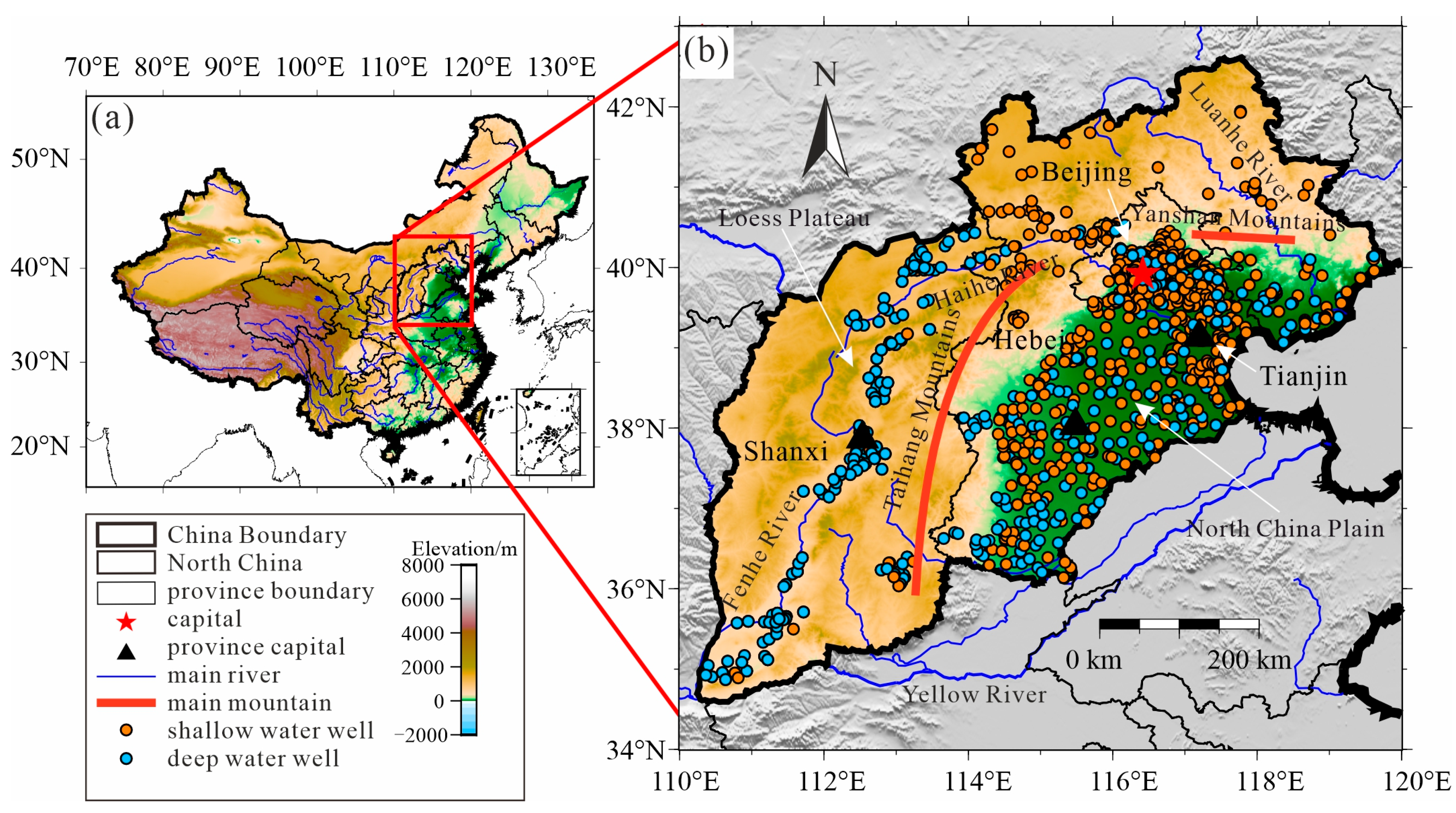

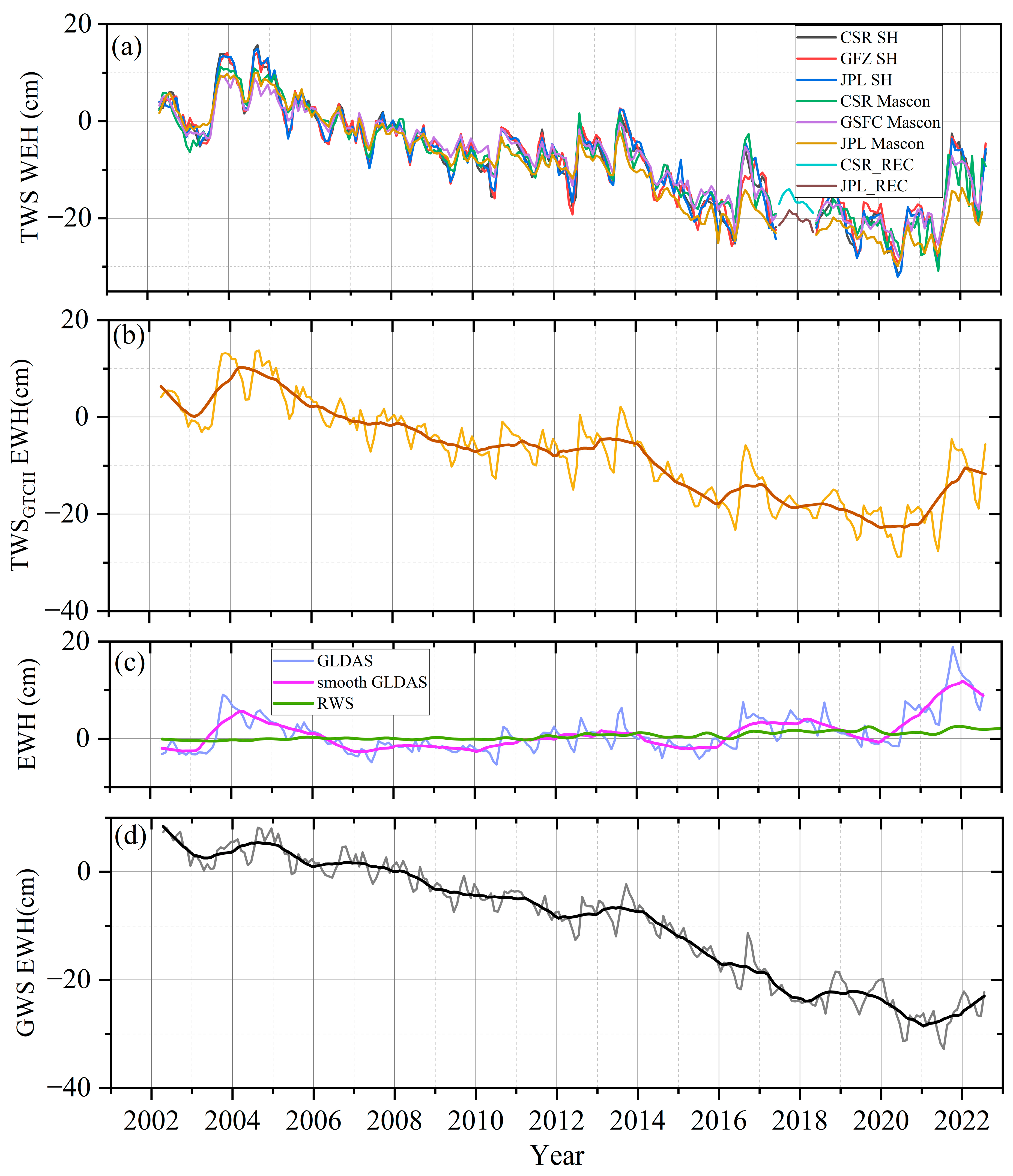


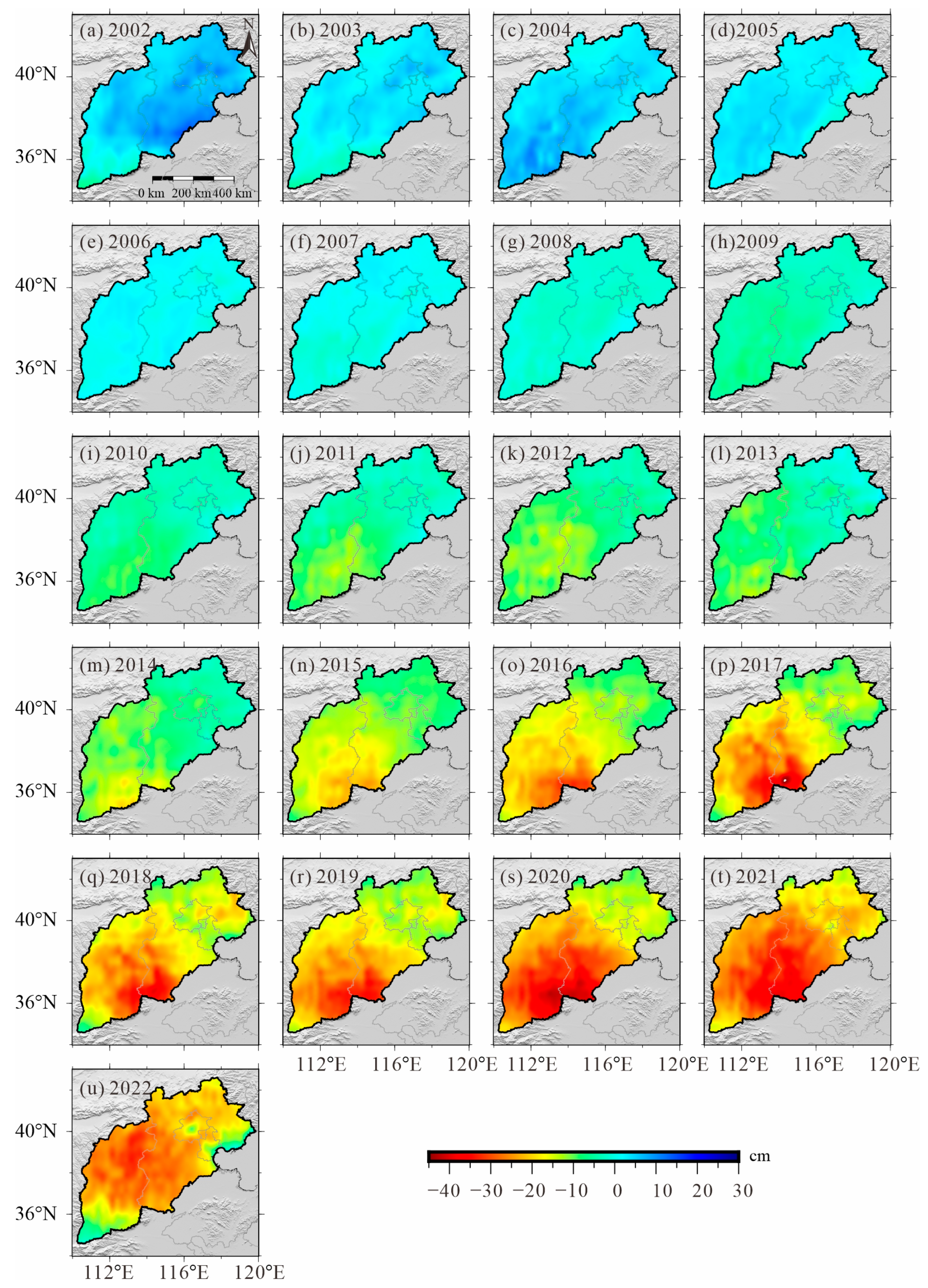


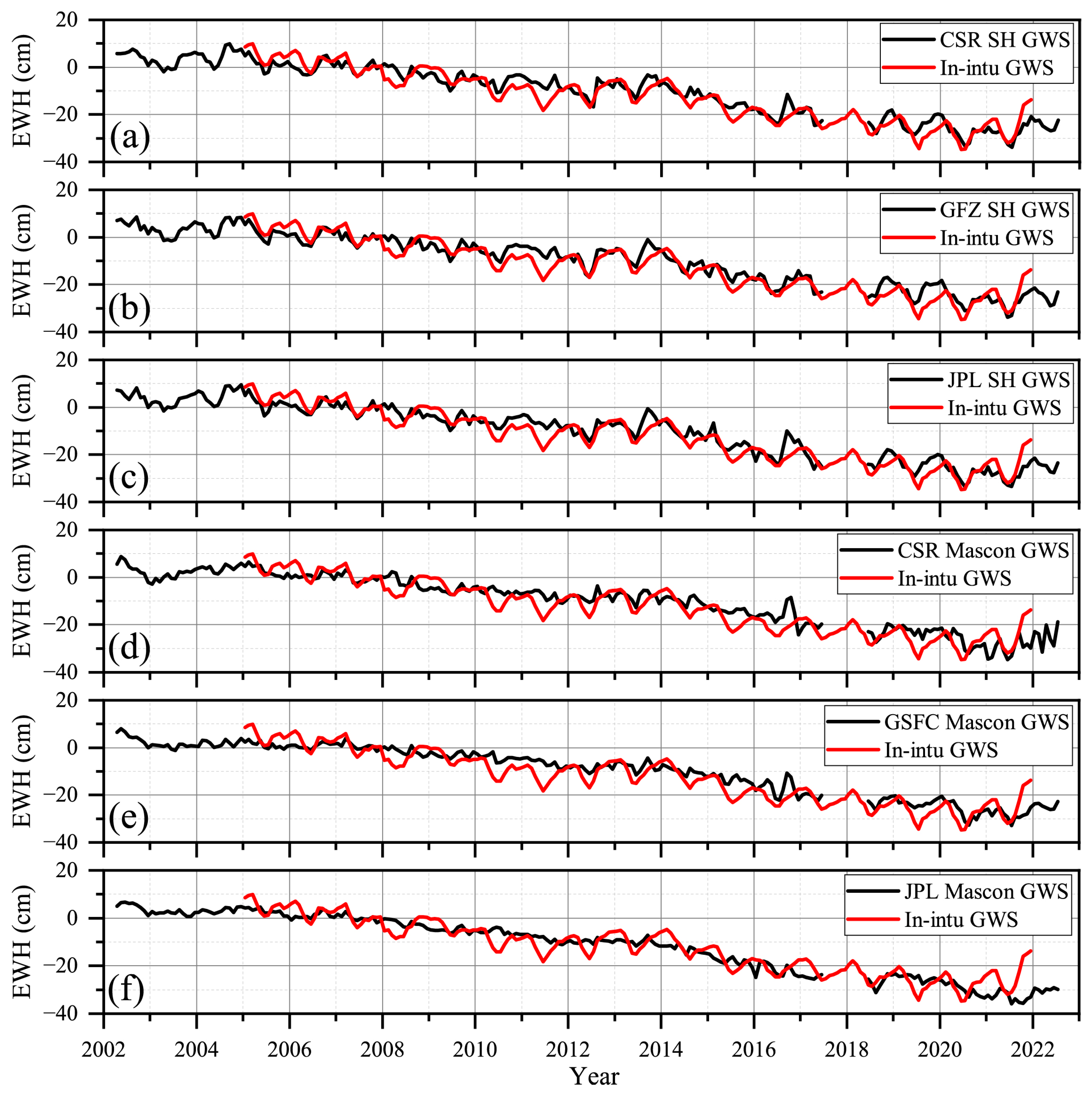
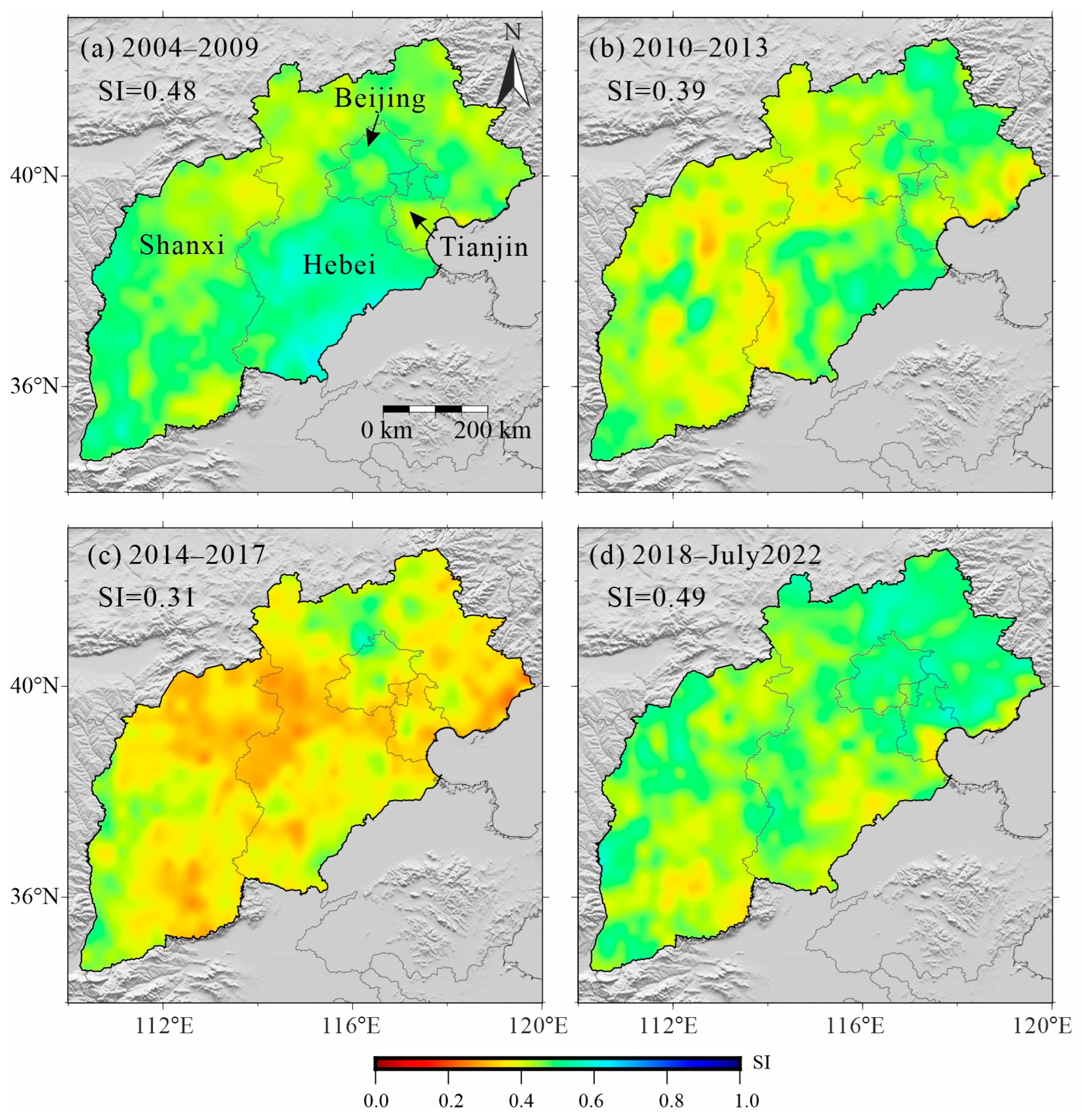
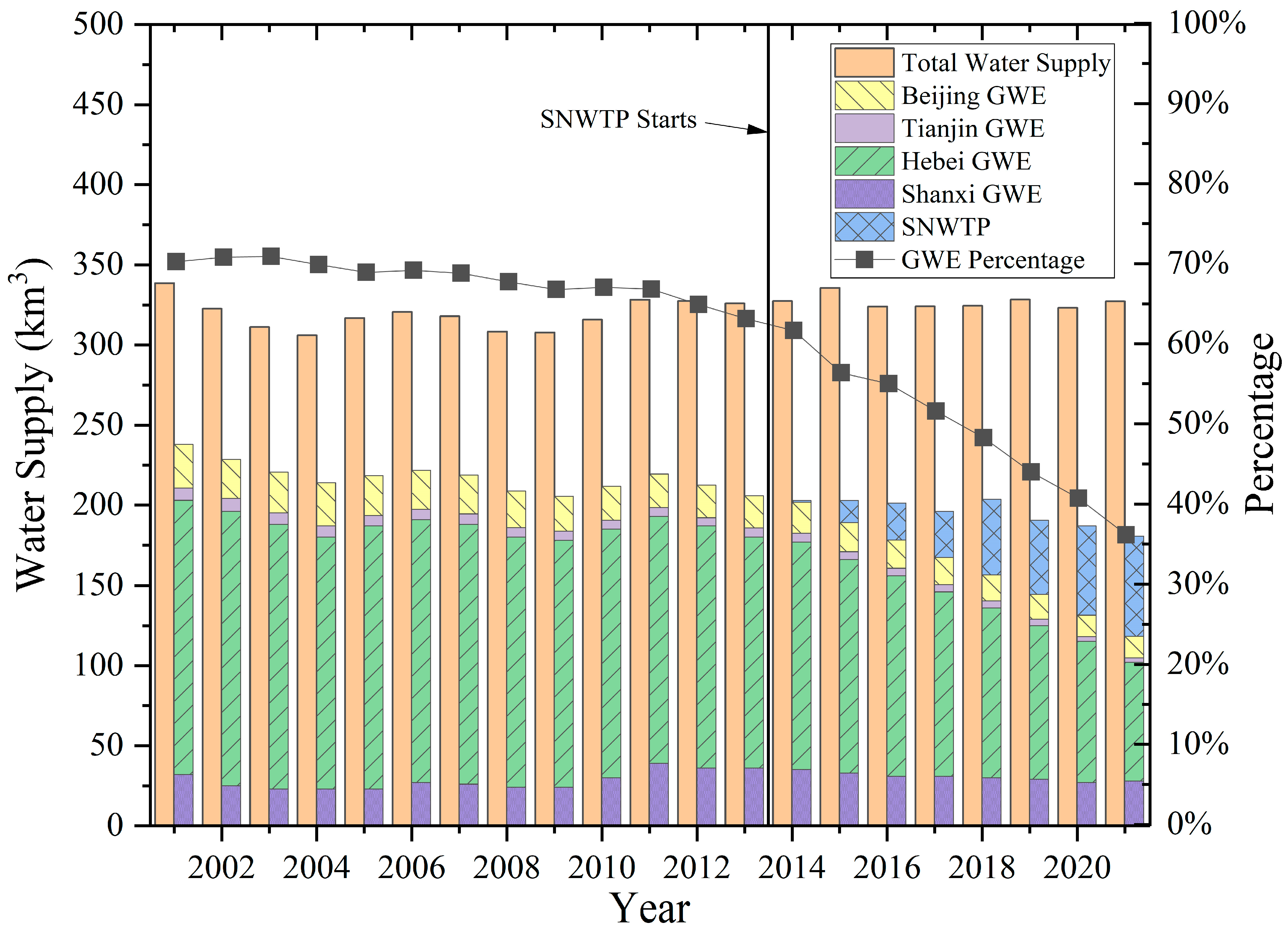
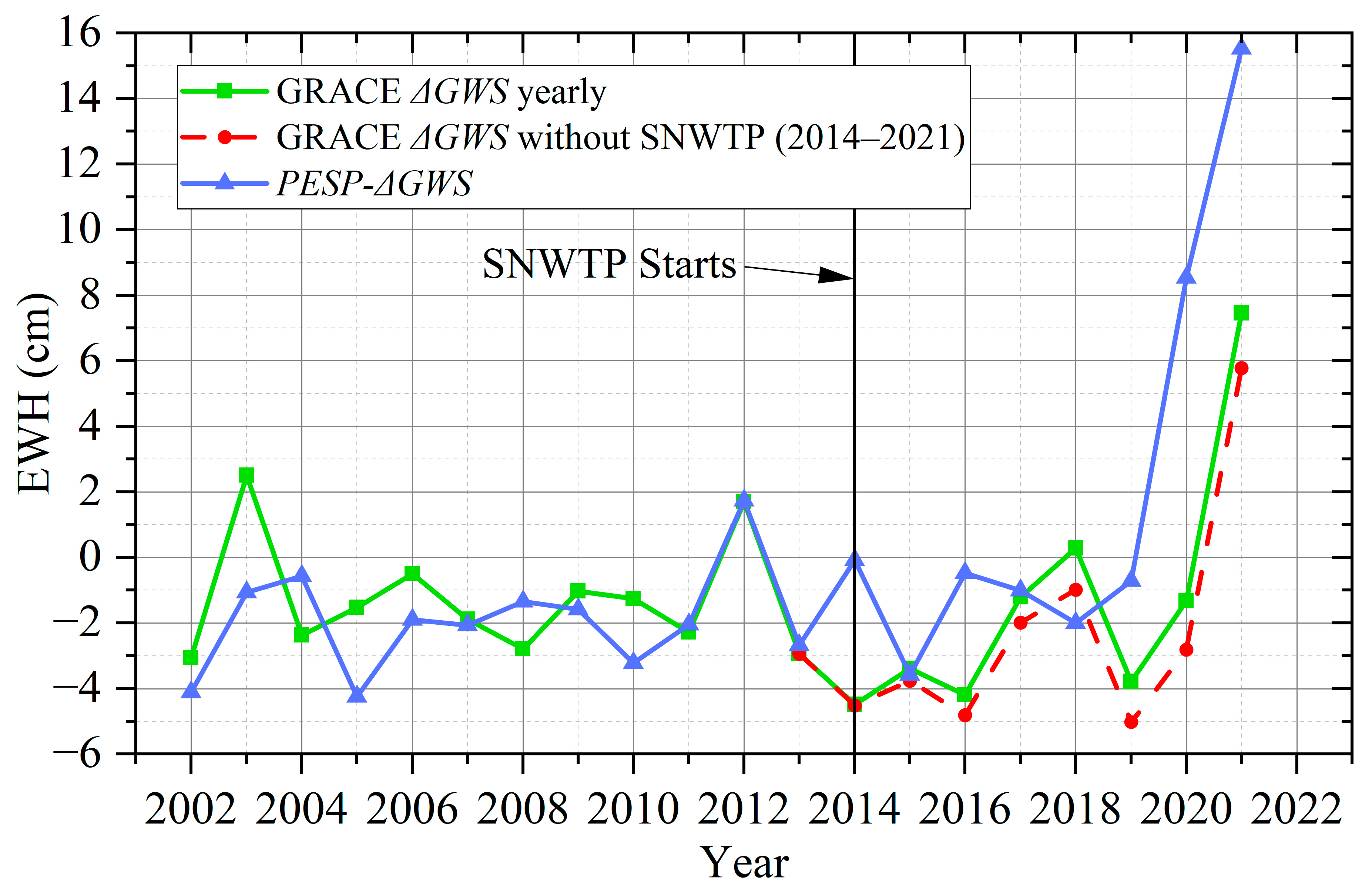
| Range of Indices | Level of Sustainability |
|---|---|
| 0 ≤ SI ≤ 0.2 | Extremely unsustainable |
| 0.2 < SI ≤ 0.4 | Severely unsustainable |
| 0.4 < SI ≤ 0.5 | Slightly unsustainable |
| 0.5 < SI ≤ 0.75 | Moderately sustainable |
| 0.75 < SI ≤ 1 | Highly sustainable |
| GRACE/GRACE-FO Data | Uncertainty (cm) | Weight P |
|---|---|---|
| CSR SH | 1.378 | 0.247 |
| GFZ SH | 1.797 | 0.145 |
| JPL SH | 1.453 | 0.223 |
| CSR Mascon | 2.006 | 0.117 |
| GSFC Mascon | 1.557 | 0.194 |
| JPL Mascon | 2.524 | 0.074 |
| Monthly ΔGWS and Rainfall | r | p-Value |
|---|---|---|
| The entire study period | 0.3183 | <0.01 |
| Pre-SNWTP (2002–2013) | 0.3841 | <0.01 |
| Post-SNWTP (2014–2022) | 0.2336 | 0.07 |
| Type | r | p-Value | Slopes |
|---|---|---|---|
| In situ GWS | |||
| CSR SH GWS | 0.94 | <0.01 | 0.87 ± 0.02 |
| GFZ SH GWS | 0.94 | <0.01 | 0.84 ± 0.02 |
| JPL SH GWS | 0.93 | <0.01 | 0.87 ± 0.02 |
| CSR Mascon GWS | 0.90 | <0.01 | 0.83 ± 0.03 |
| GSFC Mascon GWS | 0.92 | <0.01 | 0.83 ± 0.03 |
| JPL Mascon GWS | 0.91 | <0.01 | 0.94 ± 0.03 |
| Study | Datasets | Study Period | Hydrological Components | Trend (cm/a) |
|---|---|---|---|---|
| [1] | CSR SH RL04 | September 2003–March 2007 | TWS | −2.4 |
| [11] | CSR SH RL04 | August 2002–August 2010 | TWS | −1.1 |
| [12] | CSR SH RL04 | April 2002–December 2009 | TWS | −1.68 |
| [13] | CSR SH RL05 | January 2003–December 2010 | GWS | −2.2 ± 0.3 |
| [16] | CSR, GFZ, JPL SH RL05 | 2003–2011 | GWS | −1.4–−0.84 |
| [15] | CSR SH RL05 | January 2003–July 2013 | Shallow GWS | −4.65 ± 0.68 |
| Deep GWS | −1.69 ± 0.19 | |||
| [17] | CSR SH RL05 | January 2004–October 2014 | TWS | −1.13 |
| JPL SH RL05 | −1.44 | |||
| GFZ SH RL05 | −1.70 | |||
| [18] | CSR SH RL05 | April 2002–November 2014 | GWS | −5.6 ± 0.6 |
| [20] | CSR, JPL, GSFC Mascon RL05 | 2004–mid 2016 | GWS | −1.7 ± 0.1 |
| Mid 2013–mid 2016 | −3.8 ± 0.1 | |||
| [21] | CSR SH RL05 | 2003–2012 | GWS | −0.85 ± 0.10 |
| [23] | CSR SH RL05 | January 2003–June 2014 | GWS | −0.48 ± 0.07 |
| [24] | CSR, GFZ, JPL SH RL05 | 2003–2015 | TWS | −0.94 ± 0.14 |
| [27] | CSR, JPL, GSFC Mascon RL06 | June 2003–June 2017 | GWS | −2.00 ± 0.34 |
| [28] | CSR, JPL, GSFC Mascon RL06 | 2003–2014 | GWS | −1.91 ± 0.51 |
| 2015–2018 | 0.18 ± 0.07 | |||
| [29] | CSR, GFZ, JPL SH RL06 and CSR, JPL, GSFC Mascon RL06 | 2003–2014 | GWS | −1.66 ± 0.17 |
| 2015–2020 | −2.76 ± 0.55 | |||
| [30] | CSR, GFZ, JPL SH RL06 | 2004–2014 | GWS | −1.71 ± 0.18 |
| 2015–2020 | −1.91 ± 0.88 | |||
| CSR, JPL, GSFC Mascon RL06 | 2004–2014 | −1.79 ± 0.17 | ||
| 2015–2020 | −1.97 ± 0.91 | |||
| This study | CSR, GFZ, JPL SH RL06 and CSR, JPL, GSFC Mascon RL06 | August 2002–July 2022 | GWS | −1.81 ± 0.09 |
| 2004–2009 | −1.61 ± 0.37 | |||
| 2010–2013 | −0.71 ± 0.76 | |||
| 2014–2017 | −3.87 ± 0.69 | |||
| 2018–July 2022 | −1.16 ± 0.81 |
Disclaimer/Publisher’s Note: The statements, opinions and data contained in all publications are solely those of the individual author(s) and contributor(s) and not of MDPI and/or the editor(s). MDPI and/or the editor(s) disclaim responsibility for any injury to people or property resulting from any ideas, methods, instructions or products referred to in the content. |
© 2024 by the authors. Licensee MDPI, Basel, Switzerland. This article is an open access article distributed under the terms and conditions of the Creative Commons Attribution (CC BY) license (https://creativecommons.org/licenses/by/4.0/).
Share and Cite
Qu, W.; Zhang, P.; Chen, P.; Li, J.; Gao, Y. Spatiotemporal Variations and Sustainability Characteristics of Groundwater Storage in North China from 2002 to 2022 Revealed by GRACE/GRACE Follow-On and Multiple Hydrologic Data. Remote Sens. 2024, 16, 1176. https://doi.org/10.3390/rs16071176
Qu W, Zhang P, Chen P, Li J, Gao Y. Spatiotemporal Variations and Sustainability Characteristics of Groundwater Storage in North China from 2002 to 2022 Revealed by GRACE/GRACE Follow-On and Multiple Hydrologic Data. Remote Sensing. 2024; 16(7):1176. https://doi.org/10.3390/rs16071176
Chicago/Turabian StyleQu, Wei, Pufang Zhang, Peinan Chen, Jiuyuan Li, and Yuan Gao. 2024. "Spatiotemporal Variations and Sustainability Characteristics of Groundwater Storage in North China from 2002 to 2022 Revealed by GRACE/GRACE Follow-On and Multiple Hydrologic Data" Remote Sensing 16, no. 7: 1176. https://doi.org/10.3390/rs16071176
APA StyleQu, W., Zhang, P., Chen, P., Li, J., & Gao, Y. (2024). Spatiotemporal Variations and Sustainability Characteristics of Groundwater Storage in North China from 2002 to 2022 Revealed by GRACE/GRACE Follow-On and Multiple Hydrologic Data. Remote Sensing, 16(7), 1176. https://doi.org/10.3390/rs16071176







